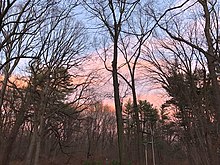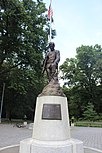Forest Park (Queens)
| Forest Park | |
|---|---|
 George Seuffert Sr. Bandshell | |
 | |
| Type | Urban park |
| Location | Queens, New York City, United States |
| Coordinates | 40°42′15″N 73°50′45″W / 40.70415°N 73.8458°W |
| Area | 538 acres (2.18 km2) |
| Created | 1895 |
| Owned by | NYC Parks |
| Status | Open all year |
| Website | https://www.nycgovparks.org/parks/Q015 |
Forest Park is a park in the
The park contains 165 acres (67 ha) of trees, including the largest continuous oak forest in Queens. Some trees are more than a century and a half old. The park sits on hills left behind by the Wisconsin glacier and is a haven for native plants and wildlife in the midst of the city's sprawl. In addition to the park's large full-time bird population, migratory birds pass through in the spring and fall.[1]
Several trails are available for area residents and urban day hikers.[2] Other facilities include playgrounds, a carousel, a running track, two dog runs, a pond, tennis courts, basketball courts, baseball fields, a skate park, and a golf course.[3] The park is operated and maintained by the New York City Department of Parks and Recreation.[4]
History
Early development

The
The site of Forest Park was occupied by various landowners until the late 19th century, when
In 1896, the landscaping firm of Olmsted, Olmsted & Eliot was contracted to provide a plan for the park.
Carousels designed by Daniel Muller were added in 1918; one of them was destroyed by fire in 1966, and the other in 1972.[9] Jackson Pond was used for fishing and ice skating, but was filled in for redevelopment.
Recent development
During the park's centennial celebration in 1995, 100 trees were planted as a part of Operation Pine Grove, funded by
A number of the parks' trees were destroyed in Hurricane Sandy and one fallen tree damaged the structure housing the Forest Park Carousel, but the damage was repaired and the carousel reopened in March 2013. The Forest Park Carousel was listed on the National Register of Historic Places in 2004.[10]
Features
Recreation and events
Within Forest Park is "The Overlook", the administration building for Queens Parks, and "Oak Ridge", the former golf-course clubhouse and current administration building for Forest Park. Forest Park also offers a wide array of recreational facilities, the Carousel,[11][12] playgrounds,[13] a pond,[14] a barbecue area,[15] the George Seuffert Sr. Bandshell,[16] a nature center,[17] and two dog runs. Dogs can run off leash here, and there is a separate area for small dogs.[18][19] Therapeutic horseback riding for people with special needs is also available in the park.[20]
Annual events such as the Halloween Walk, the Victorian Christmas, Nature Trails Day, orienteering and battle re-enactments draw the participation of the surrounding neighborhoods of Kew Gardens, Woodhaven, Richmond Hill, Forest Hills, and Glendale.
Landscape features
Wildlife and vegetation

Birds common to Forest Park include red-tailed hawks, a variety of woodpeckers, great blue herons, mallards, northern orioles, American kestrels, ruby throated hummingbirds, ring-necked pheasants, northern flickers, eastern wood pewees, tufted titmice, white-breasted nuthatches, wood thrushes, red-eyed vireos, red-winged blackbirds, scarlet tanagers, and several species of sparrow including rufous-sided towhees.[22][23] A great variety of warblers often pass through in the spring.[24] According to the New York City Parks Department, more than 100 species of migratory birds visit the park each year.[1]

Chipmunks become visibly active in spring, along with the squirrels, raccoons, and skunks that are more often seen year-round.[1] Turtles sun themselves in Strack Pond on warm days. On summer nights, cicada song fills the area and surrounding neighborhoods.[1] Toads also can be heard croaking in the evenings. In mid-summer, hatching butterflies begin to gravitate to the Joe Pye Weed, dogbane, milkweed, thistle, and other native plants.[1] Fall brings spectacular color, as many varieties of trees prepare to drop their leaves. Several species of hawks pass through.[1] Winter is quiet, featuring the occasional tracks of small mammals in snow.[1]
Forest Park's trees include the Northern red oak (
The park was ravaged in 1912 by the chestnut blight, and for a time was used for lumbering; about the same time, greenhouses were set up to grow plants for parks throughout the city.[9] These have since been moved to the Brooklyn Botanic Garden and Bronx Park.
Transportation
Public transport
Forest Park is accessible by the
The
Other
In 1895, Olmsted observed that two lines of the
The
References
- ^ a b c d e f g h "Forest Park Queens, A Guide to the Natural Areas" (PDF). NYC Parks Department.
- ^ "Forest Park Hiking Trails : NYC Parks". www.nycgovparks.org. Retrieved April 21, 2019.
- ^ "Forest Park : NYC Parks". www.nycgovparks.org. Retrieved April 21, 2019.
- ^ a b City of New York; The Green Book Official Directory of the City of New York 2005-2006 Edition; P.265.
- ^ "Forest Park : NYC Parks". New York City Department of Parks & Recreation. June 26, 1939. Retrieved March 11, 2019.
- ^ Xu, Susan (November 2, 2016). "The Top 10 Secrets of Forest Park in Queens, NYC". Untapped Cities. Retrieved March 20, 2018.
- ^ "Forest Park". nycgovparks.org.
- ^ Woodhaven Cultural and Historical Society (September 8, 2018). "Oak Ridge house in Forest Park is rich in Queens history: Our Neighborhood, The Way it Was". QNS.com. Retrieved May 31, 2019.
- ^ ISBN 0300055366.
- ^ "National Register Information System". National Register of Historic Places. National Park Service. July 9, 2010.
- ^ "Forest Park Carousel Amusement Village Opens for the 2018 Season". Amusement Today. March 19, 2018. Retrieved March 20, 2018.
- ^ "Forest Park Carousel in Queens gets ready for another go-round of spring and summer fun". QNS.com. March 19, 2018. Retrieved March 20, 2018.
- ^ "Forest Park Playgrounds : NYC Parks". www.nycgovparks.org. Retrieved March 20, 2018.
- ^ a b Joiner, Bryan (May 27, 2004). "Strack Memorial Pond Unveiled After Two Years Of Construction". Queens Chronicle. Retrieved March 9, 2020.
- ^ "Forest Park Barbecuing Areas : NYC Parks". www.nycgovparks.org. Retrieved March 20, 2018.
- ^ "Forest Park Highlights - George Seuffert, Sr. Bandshell : NYC Parks". www.nycgovparks.org. Retrieved March 20, 2018.
- ^ "Forest Park Nature Centers : NYC Parks". www.nycgovparks.org. Retrieved March 20, 2018.
- ^ "Forest Park Dog Run". www.bringfido.com. Retrieved March 20, 2018.
- ^ "Forest Park Barking Lot - Dog Park in Kew Gardens Forest Hills Queens NYC". Forest Park Barking Lot. Retrieved April 21, 2019.
- ^ "GallopNYC brings therapeutic horseback riding to Forest Hills". TimesLedger. Archived from the original on March 21, 2018. Retrieved March 20, 2018.
- ISBN 978-1-58157-566-8.
- ^ "Birding at NYC Parks : NYC Parks". www.nycgovparks.org. Retrieved April 21, 2019.
- ^ "Birding Map of Forest Park" (PDF). NYC Parks Department.
- ^ "The Waterhole at Forest Park: The Best Place in New York City to See Wood-Warblers". 10,000 Birds. May 18, 2015. Retrieved April 21, 2019.
- ^ "Queens Bus Map" (PDF). Metropolitan Transportation Authority. August 2022. Retrieved September 29, 2022.
- ^ "Forest Park". nycgovparks.org.




